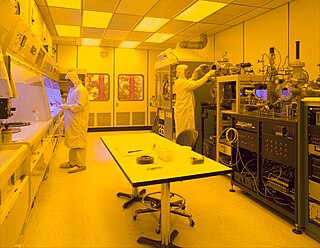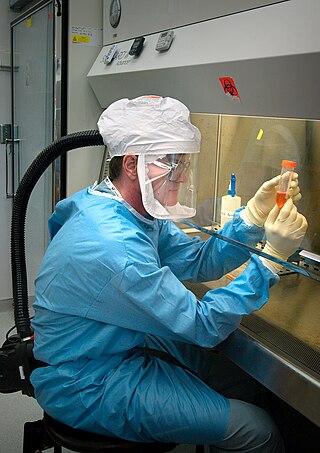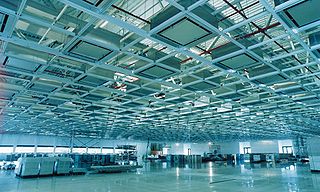Related Research Articles

Heating, ventilation, and air conditioning (HVAC) is the use of various technologies to control the temperature, humidity, and purity of the air in an enclosed space. Its goal is to provide thermal comfort and acceptable indoor air quality. HVAC system design is a subdiscipline of mechanical engineering, based on the principles of thermodynamics, fluid mechanics, and heat transfer. "Refrigeration" is sometimes added to the field's abbreviation as HVAC&R or HVACR, or "ventilation" is dropped, as in HACR.

A cleanroom or clean room is an engineered space that maintains a very low concentration of airborne particulates. It is well isolated, well controlled from contamination, and actively cleansed. Such rooms are commonly needed for scientific research and in industrial production for all nanoscale processes, such as semiconductor manufacturing. A cleanroom is designed to keep everything from dust to airborne organisms or vaporised particles away from it, and so from whatever material is being handled inside it.

HEPA filter, also known as a high-efficiency particulate arresting filter, is an efficiency standard of air filters.
An air purifier or air cleaner is a device which removes contaminants from the air in a room to improve indoor air quality. These devices are commonly marketed as being beneficial to allergy sufferers and asthmatics, and at reducing or eliminating second-hand tobacco smoke.

A particulate air filter is a device composed of fibrous, or porous materials which removes particulates such as smoke, dust, pollen, mold, viruses and bacteria from the air. Filters containing an adsorbent or catalyst such as charcoal (carbon) may also remove odors and gaseous pollutants such as volatile organic compounds or ozone. Air filters are used in applications where air quality is important, notably in building ventilation systems and in engines.

A diesel particulate filter (DPF) is a device designed to remove diesel particulate matter or soot from the exhaust gas of a diesel engine.
Ultra-low particulate air (ULPA) is a type of air filter. A ULPA filter can remove from the air at least 99.999% of dust, pollen, mold, bacteria and any airborne particles with a minimum particle penetration size of 120 nanometres. A ULPA filter can remove—to a large extent but not 100%—oil smoke, tobacco smoke, rosin smoke, smog, and insecticide dust. It can also remove carbon black to some extent. Some fan filter units incorporate ULPA filters. The EN 1822 and ISO 29463 standards may be used to rate ULPA filters.

A dust collector is a system used to enhance the quality of air released from industrial and commercial processes by collecting dust and other impurities from air or gas. Designed to handle high-volume dust loads, a dust collector system consists of a blower, dust filter, a filter-cleaning system, and a dust receptacle or dust removal system. It is distinguished from air purifiers, which use disposable filters to remove dust.
The term wet scrubber describes a variety of devices that remove pollutants from a furnace flue gas or from other gas streams. In a wet scrubber, the polluted gas stream is brought into contact with the scrubbing liquid, by spraying it with the liquid, by forcing it through a pool of liquid, or by some other contact method, so as to remove the pollutants.
Aerobiological engineering is the science of designing buildings and systems to control airborne pathogens and allergens in indoor environments. The most-common environments include commercial buildings, residences and hospitals. This field of study is important because controlled indoor climates generally tend to favor the survival and transmission of contagious human pathogens as well as certain kinds of fungi and bacteria.
A hypoallergenic vacuum cleaner is a vacuum cleaner with filters designed to retain the vast majority of particles within the vacuum system. If successful this retention would greatly reduce the amount of potential allergens in the environment in which it is used. Regular vacuum cleaners are unable to retain most very fine dust and many allergens which simply are too small for the system to trap and are released from the system along with the exhaust air.

A biosafety cabinet (BSC)—also called a biological safety cabinet or microbiological safety cabinet—is an enclosed, ventilated laboratory workspace for safely working with materials contaminated with pathogens requiring a defined biosafety level. Several different types of BSC exist, differentiated by the degree of biocontainment they provide. BSCs first became commercially available in 1950.
ANSI/ASHRAE/IES Standard 90.1: Energy Standard for Buildings Except Low-Rise Residential Buildings is an American National Standards Institute (ANSI) standard published by ASHRAE and jointly sponsored by the Illuminating Engineering Society (IES) that provides minimum requirements for energy efficient designs for buildings except for low-rise residential buildings. The original standard, ASHRAE 90, was published in 1975. There have been multiple editions to it since. In 1999 the ASHRAE Board of Directors voted to place the standard on continuous maintenance, based on rapid changes in energy technology and energy prices. This allows it to be updated multiple times in a year. The standard was renamed ASHRAE 90.1 in 2001. It has since been updated in 2004, 2007, 2010, 2013, 2016, and 2019 to reflect newer and more efficient technologies.

The clean air delivery rate (CADR) is a figure of merit that is the cubic feet per minute (CFM) of air that has had all the particles of a given size distribution removed. For air filters that have air flowing through them, it is the fraction of particles that have been removed from the air, multiplied by the air flow rate through the device. More precisely, it is the CFM of air in a 1,008-cubic-foot (28.5 m3) room that has had all the particles of a given size distribution removed from the air, over and above the rate at which the particles are naturally falling out of the air. Different filters have different abilities to remove different particle distributions, so three CADR's for a given device are typically measured: smoke, pollen, and dust. By combining the amount of airflow and particle removal efficiency, consumers are less likely to be misled by a high efficiency filter that is filtering a small amount of air, or by a high volume of air that is not being filtered very well.

A fan filter unit (FFU) is a type of motorized air filtering equipment. It is used to supply purified air to cleanrooms, laboratories, medical facilities or microenvironments by removing harmful airborne particles from recirculating air. The units are installed within the system's ceiling or floor grid. Large cleanrooms require a proportionally large number of FFUs, which in some cases may range from several hundred to several thousand. Units often contain their own pre-filter, HEPA filter and internally controllable fan air distribution.
The Microparticle Performance Rating (MPR) is an air filter rating system created by the company 3M. It rates the ability of an air filter to filter out micro particles.

The NIOSH air filtration rating is the U.S. National Institute for Occupational Safety and Health (NIOSH)'s classification of filtering respirators. The ratings describe the ability of the device to protect the wearer from solid and liquid particulates in the air. The certification and approval process for respiratory protective devices is governed by Part 84 of Title 42 of the Code of Federal Regulations. Respiratory protective devices so classified include air-purifying respirators (APR) such as filtering facepiece respirators and chemical protective cartridges that have incorporated particulate filter elements.
Air filtration guidelines for operating rooms are determined by the American Society of Heating, Refrigerating and Air-Conditioning Engineers (ASHRAE) using a standard known as Minimum Efficiency Reporting Value (MERV). MERV is determined based on the size of particles successfully removed from the air and is used to classify the efficiency of HEPA filters. Ratings range from 1-16 and efficiency increases as the rating increases. ASHRAE groups surgeries into three categories: minor surgical procedures (A); minor or major surgical procedures performed with minor sedation (B); and major surgical procedures performed with general anesthesia or regional block anesthesia (C). Each surgical category is given a minimum MERV rating it must comply with.

Mechanical filters, a part of particulate respirators, are a class of filter for air-purifying respirators that mechanically stops particulates from reaching the wearer's nose and mouth. They come in multiple physical forms.

The Corsi–Rosenthal Box is a design for a do-it-yourself air purifier that can be built comparatively inexpensively. It consists of four or five HVAC particulate air filters that form a cube and a box fan to draw air through the filters. The seams of the cube are sealed with duct tape. A 2022 study found the clean air delivery rate on the five-filter design was between 600–850 cubic feet (17–24 m3) per minute, costing roughly a tenth of commercial air filters. Engineers Richard Corsi and Jim Rosenthal created the five-filter design during the COVID-19 pandemic, with the goal of reducing the risk of infection by reducing the levels of airborne viral particles in indoor settings.
References
- 1 2 3 4 "Residential Air Cleaners (2nd Edition): A Summary of Available Information" (PDF). EPA. Archived from the original (PDF) on February 1, 2013. Retrieved 2012-08-20.
- ↑ Best Air Filters for Your Home
- 1 2 MERV vs. MPR vs. FPR Rating Systems